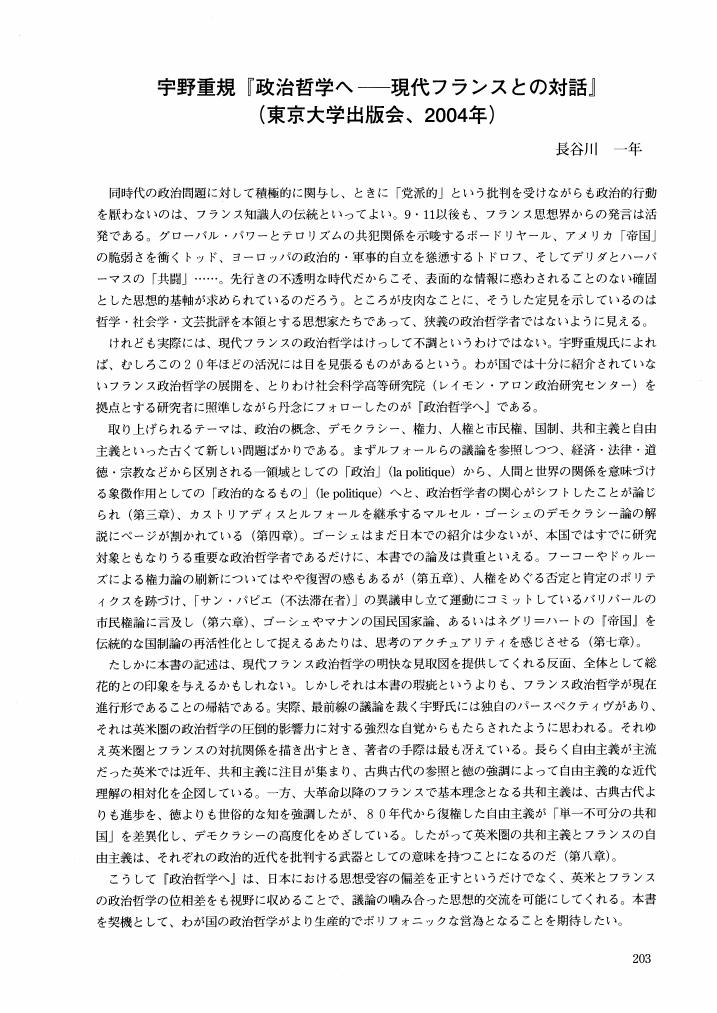1 0 0 0 OA モノグラフ・サヴァイヴァル : アメリカにおける学術出版の電子化と「人文学の危機」
- 著者
- 長谷川 一
- 出版者
- 日本マス・コミュニケーション学会
- 雑誌
- マス・コミュニケーション研究 (ISSN:13411306)
- 巻号頁・発行日
- vol.62, pp.98-115, 2003-01-31 (Released:2017-10-06)
This paper criticizes the current situation of electronic scholarly publishing in the United States from a cultural politics point of view. In most of the humanities, monographs are the central media. Being their main publishers, the university presses have always been inseparable from the knowledge production system. However, the commercialization of the presses accelerated rapidly after the 1990s. This has not only made it difficult for untenured young scholars to publish monographs, but has also had a negative impact on the cycle of knowledge production. To solve the issue, various possibilities of electronic publishing have been discussed. The History E-Book project is expected to play a central role. This large-scale project has participants from many historical studies associations and leading university presses, as well as considerable foundation support. In this paper, I would like to present an outline of the project, which is led by the well-known historian Robert Darnton. It will become clear that Darnton has only replaced paper with electronic forms, without any structural changes. In other words, he has automatically shifted the structure of the present knowledge production system based on a codex to cyberspace. The fundamental element which forms the monograph is the idea of "work," a coherent concept or idea unique to the author. This "work" is secured by the codex as physical form. How then can the electronic monographs with no physical form sustain the idea of "work"? Furthermore, given the fact that the significance of humanities, including historical studies, has declined remarkably in the United States in the 1990s, the History E-Book project is also expected to redress the "humanities crisis." However, the project has no such potential. The current situation should be understood as a sign of conflict caused by changes in the constellation of modern knowledge.
- 著者
- 長谷川 一
- 出版者
- 科学技術振興機構
- 雑誌
- 情報管理 = Journal of information processing and management (ISSN:00217298)
- 巻号頁・発行日
- vol.60, no.9, pp.651-654, 2017-12
1 0 0 0 IR 井上筑後守政重の海外知識について
- 著者
- 長谷川 一夫
- 出版者
- 法政大学史学会
- 雑誌
- 法政史学 (ISSN:03868893)
- 巻号頁・発行日
- no.21, pp.125-137, 1969-03
1 0 0 0 パーキンソン病の病態に合わせた薬の選択と使い方
- 著者
- 長谷川 一子
- 出版者
- 公益社団法人 日本薬学会
- 雑誌
- ファルマシア (ISSN:00148601)
- 巻号頁・発行日
- vol.49, no.9, pp.844-848, 2013
- 参考文献数
- 8
1 0 0 0 OA スポーツによる顎顔面骨骨折
- 著者
- 前田 剛 春山 秀遠 山下 正義 大野 奈穂子 石崎 菜穂 長谷川 一弘 田中 茂男 渋谷 諄 小宮 正道 牧山 康秀 秋元 芳明 平山 晃康 片山 容一
- 出版者
- 日本脳神経外科コングレス
- 雑誌
- 脳神経外科ジャーナル (ISSN:0917950X)
- 巻号頁・発行日
- vol.15, no.7, pp.517-522, 2006-07-20
- 被引用文献数
- 4
スポーツによる顎顔面骨骨折は,交通事故,転落・転倒に次いで3番目に多く,10〜20歳代の男性が大多数を占めた.種目では野球/ソフトボールが最も多く,次いで空手,サッカー,ラグビー,ボクシングの順であった.受傷原因は,格闘技においては全例が打撃を含めた対人衝突であったが,球技においても大多数が対人衝突による受傷であった.骨折の好発部位は下顎骨体部であり,多発骨折例では下顎骨体部と対側の角部との骨折が最も多く認められた.スポーツによる頭蓋顎顔面骨骨折の特徴を十分理解したうえで,マウスガードやフェイスガード付ヘルメットなど各種スポーツの特性にあった予防対策の検討を行うことが必要であると考えられた.
1 0 0 0 OA 宇野重規『政治哲学へ-現代フランスとの対話』 (東京大学出版会、2004年)
- 著者
- 長谷川 一年
- 出版者
- 政治思想学会
- 雑誌
- 政治思想研究 (ISSN:1346924X)
- 巻号頁・発行日
- vol.5, pp.203-203, 2005-05-10 (Released:2012-11-20)
1 0 0 0 カルシウム拮抗薬の歯肉増殖症発生頻度
1 0 0 0 大型有形文化財計測のための気球搭載型レンジセンサ
- 著者
- 阪野貴彦 長谷川 一英 池内 克史
- 出版者
- 一般社団法人情報処理学会
- 雑誌
- 情報処理学会研究報告コンピュータビジョンとイメージメディア(CVIM) (ISSN:09196072)
- 巻号頁・発行日
- vol.2005, no.18, pp.213-220, 2005-03-04
- 被引用文献数
- 7
巨大物体の3次元形状計測では,クレーンやヘリコプタ等を利用した空中からのスキャンが効果的な方法の1つとして考えられる.ただし,対象物体が貴重な文化遺産である場合,安全性や効率性の面から,このような計測にはさまざまな問題が発生する.そのためわれわれは,レンジセンサを気球に搭載したFlying Laser Range Sensor(FLRS)を開発した.しかし,FLRSでは計測中にレンジセンサが運動するため,獲得する形状データに歪みが生じてしまう.そこで,本稿では計測中に移動するレンジセンサから得られるデータを補正する手法を提案する.まず,気球に取り付けたビデオカメラによる画像列と,歪んだ形状データそのものから抽出できる情報を用いて,カメラ運動に関するパラメータの高精度な推定をおこなう.このとき,初期解としてFull-Perspective Factorizationを用いた.推定されたセンサの運動パラメータを用いて,歪んだ形状データを補正した.この手法をカンボジア,バイヨン寺院の計測に適用したところ,FLRSから得られた歪んだ形状データを精度良く復元することができた.For a large scale object, scanning from the air is one of the most efficient methods of obtaining 3D data.In the case of large cultural heritage objects, there are some difficulties in scanning them with respect to safety and efficiency. To remedy these problems, we have been developing a novel 3D measurement system, the Flying Laser Range Sensor (FLRS) , in which a rage sensor is suspended beneath a balloon.The obtained data, however, have some distortion due to the intra-scanning movement.In this paper, we propose a method to recover 3D range data obtained by a moving laser range sensor; this method is applicable not only to our FLRS, but also to a general moving range sensor.Using image sequences from a video camera mounted on the FLRS enables us to estimate the motion of the FLRS without any physical sensors such as gyros and GPS.At first, the initial values of camera motion parameters are estimated by perspective factorization.The next stage refines camera motion parameters using the relationships between camera images and the range data distortion.Finally, by using the refined parameter, the distorted range data are recovered. We applied this method to an actual scanning project and the results showed the effectiveness of our method.
1 0 0 0 自殺事故関連文書の提出命令と開示の可否について
- 著者
- 長谷川 一朗
- 出版者
- 消防通信社
- 雑誌
- 消防通信 (ISSN:09170987)
- 巻号頁・発行日
- vol.37, no.1, pp.36-38, 2010-01
1 0 0 0 ピンポン漏話雑音環境下におけるADSL通信方式の一提案
- 著者
- 小泉 伸一 村田 博康 佐々木 啓 粟田 豊 長谷川 一知 三好 清司
- 出版者
- 一般社団法人電子情報通信学会
- 雑誌
- 電子情報通信学会ソサイエティ大会講演論文集
- 巻号頁・発行日
- vol.1998, no.2, 1998-09-07

